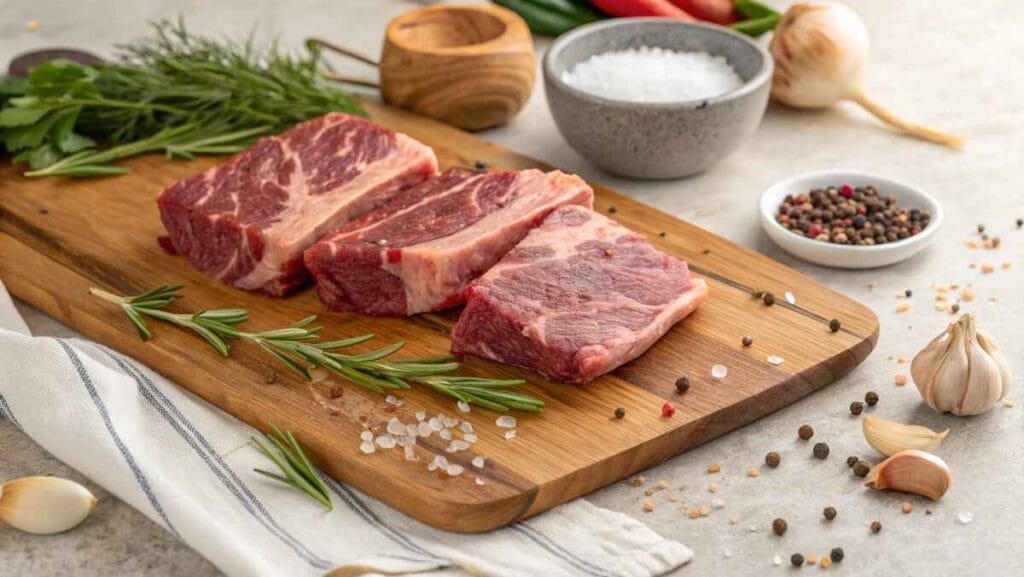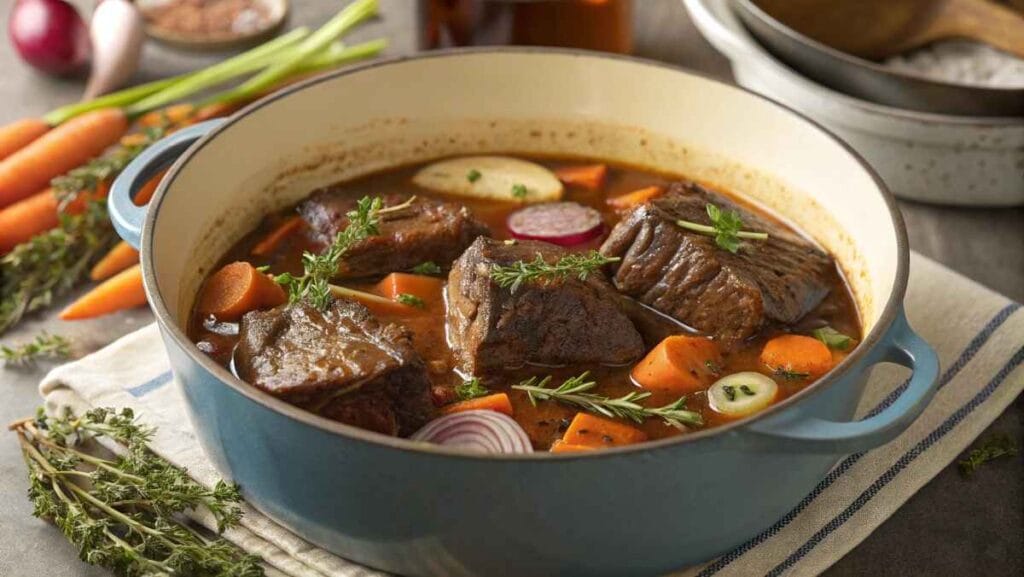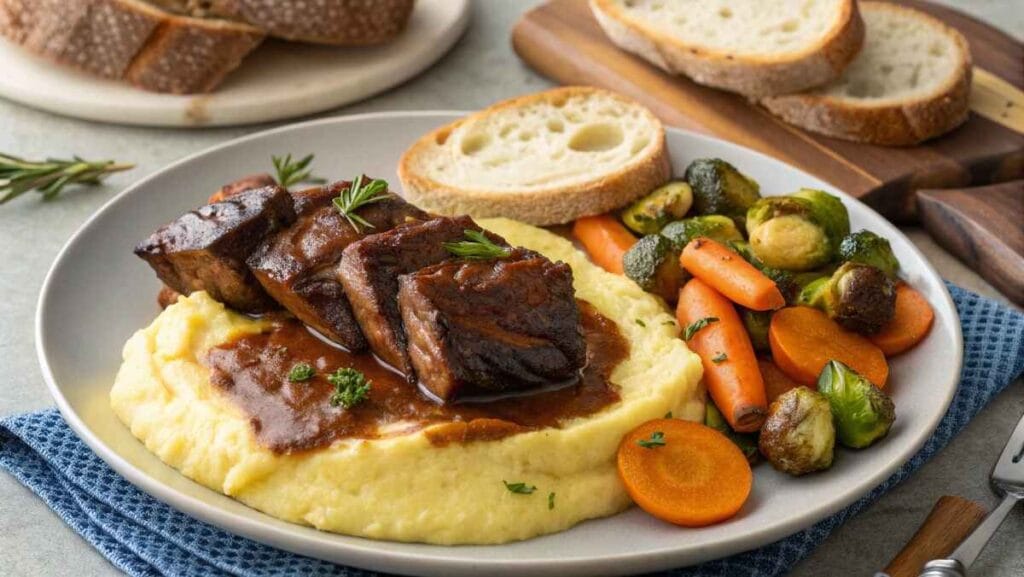Table of Contents
If you’re looking for the perfect boneless beef short ribs recipe, you’re in the right place. This guide will take you step-by-step through the process of selecting the best cuts, preparing the meat, and mastering the cooking techniques to create a dish that is tender, flavorful, and unforgettable.
Introduction and Preparation
What Are Boneless Beef Short Ribs?
Boneless beef short ribs are derived from the chuck or plate section of the cow. Unlike traditional short ribs, they lack the bone, making them more versatile and easier to cook. Their well-marbled texture ensures a juicy, tender bite every time.
These ribs are loved for their robust flavor, which comes from the connective tissues breaking down during slow cooking. Thanks to their versatility, you can use them in a variety of dishes, from classic braises to fusion-inspired creations.
Why Slow-Cooked Short Ribs Are Irresistible
The magic of slow cooking lies in its ability to transform tough cuts of meat into something truly remarkable. Boneless beef short ribs are the perfect candidate for this cooking method. Over time, the connective tissues dissolve, infusing the meat with flavor while creating a sauce that’s rich and savory.
- Flavor Profile: Slow-cooked ribs are deep, beefy, and satisfying.
- Tenderness: The longer they cook, the more they melt in your mouth.
- Traditional Methods: Braising, a process of cooking meat in liquid, has been used for centuries to enhance tough cuts.
If you’re looking for a spicier twist, you might enjoy our recipe for Easy Chipotle Steak Magic, which offers smoky and zesty flavors.
How to Select the Best Boneless Beef Short Ribs recipe
The key to a delicious dish starts with high-quality meat. Here’s what to look for:
- Marbling: Choose ribs with visible streaks of fat throughout the meat for flavor.
- Color: Opt for cuts with a bright, cherry-red hue.
- Texture: Avoid meat that feels slimy or overly wet.
For premium cuts, consider shopping at butcher shops or specialty stores. Farmers’ markets and online meat purveyors are also excellent sources for grass-fed or organic beef.
Essential Kitchen Tools
To make perfect boneless beef short ribs, having the right tools on hand is crucial. Here are the essentials:
- Dutch Oven: Ideal for even heat distribution and perfect for braising.
- Slow Cooker: A convenient alternative for hands-free cooking.
- Sharp Knife: Necessary for trimming excess fat.
- Tongs: Helpful for searing the meat without damaging it.
- Optional Tools: An instant-read thermometer for precise cooking and a fat separator for healthier sauces.
Investing in quality tools will elevate your cooking experience, ensuring consistent results every time.

Ingredients for Success
The beauty of this recipe lies in its simplicity. You’ll need:
- Boneless Beef Short Ribs: The star of the show.
- Aromatics: Onion, garlic, and celery to build the flavor base.
- Seasonings: Salt, pepper, thyme, and rosemary for a savory touch.
- Braising Liquid: Choose from beef stock, red wine, or beer for depth of flavor.
Optional Add-Ins: Carrots, mushrooms, or pearl onions can enhance the dish’s complexity.
Pro Tip: Fresh herbs and high-quality liquids can make a noticeable difference. Splurge on a good bottle of wine for the braising liquid—it’s worth it!
Preparing the Meat
Before cooking, prepare the short ribs by:
- Trimming: Remove excess fat, but leave some for flavor.
- Seasoning: Generously season with salt and pepper, pressing it into the meat.
- Marinating (Optional): For enhanced flavor, marinate the ribs in a mixture of wine, soy sauce, or vinegar for 2–4 hours.
Taking these extra steps ensures that your short ribs are bursting with flavor from the very first bite.
Comparing Cooking Methods
Boneless beef short ribs can be cooked using a variety of techniques. Each method has its pros and cons:
| Method | Advantages | Challenges |
|---|---|---|
| Stove-Top | Quick setup, easy monitoring | Requires constant attention |
| Oven | Even cooking, hands-off approach | Longer cooking time |
| Slow Cooker | Convenient, perfect for busy days | May lack the depth of a braise |
Ultimately, the choice depends on your schedule and personal preference.
Time Management Tips
Cooking short ribs requires patience, but a little planning can make the process stress-free:
- Stove-Top: 2–2.5 hours.
- Oven: 3 hours at 325°F (162°C).
- Slow Cooker: 6–8 hours on low.
For a busy weeknight, you can prepare the dish in advance and reheat it before serving. Short ribs often taste even better the next day as the flavors have more time to meld.
Avoiding Common Mistakes
Even experienced cooks can encounter issues when making short ribs. Here are the most common pitfalls and how to avoid them:
- Overcooking: Leads to dry, stringy meat. Keep an eye on the timer and check for doneness regularly.
- Skipping the Browning Step: Searing locks in flavor and adds a caramelized crust that enhances the final dish.
- Undersalting: Remember, slow cooking dilutes seasoning. Be generous but mindful when seasoning your meat and braising liquid.
Mastering these basics ensures your dish is a success every time.
Step-by-Step Cooking Process
boneless beef short ribs recipe is a dish that features short ribs of beef without the bones:
- Searing: Locks in juices and builds flavor.
- Braising: Breaks down the meat’s connective tissues.
- Resting: Enhances tenderness and ensures optimal texture.
Each step is critical to creating a restaurant-quality dish at home.
The Importance of Searing
Searing the meat is a step you should never skip. It creates a caramelized crust, giving your dish depth and richness.
How to Sear Perfectly
- Heat a large skillet or Dutch oven over medium-high heat.
- Add a small amount of oil with a high smoke point, like canola or grapeseed oil.
- Sear the ribs for 2–3 minutes per side until a golden crust forms.
Pro Tip: Avoid overcrowding the pan. Sear the ribs in batches to maintain a high temperature, which is crucial for proper browning.
Creating the Perfect Braising Liquid
The braising liquid is the foundation of flavor. Here’s how to craft it:
Choosing the Right Liquid
- Wine: Red wine adds a rich, bold flavor.
- Broth: Beef or chicken broth creates a savory base.
- Beer: Dark ales or stouts impart earthy, malty notes.
Aromatics for Depth
Include onions, garlic, celery, and fresh herbs like thyme and rosemary. For an added kick, incorporate spices such as smoked paprika or cumin.
Once combined, the liquid should cover about two-thirds of the ribs. This ensures even cooking while allowing some of the meat to caramelize above the liquid.
Braising Techniques
Braising involves cooking meat slowly in liquid over low heat. Here are the most popular methods:
Traditional Stove-Top Braising
- After searing, deglaze the pan with your chosen braising liquid, scraping up any browned bits.
- Add the meat back to the pot, cover, and simmer on low heat for 2–2.5 hours.
Slow Cooker Method
- Step 1: Sear the ribs as usual, then transfer them to the slow cooker.
- Step 2: Add the braising liquid and set to low heat for 6–8 hours.
- Step 3: Check for tenderness before serving.
For busy days, this method is a lifesaver. While it lacks some of the depth achieved in traditional braising, it’s unbeatable for convenience.
Oven Braising
- Preheat the oven to 325°F (162°C).
- Follow the stove-top braising steps, then transfer the pot to the oven.
- Cook for 2.5–3 hours, checking periodically to ensure the liquid doesn’t evaporate.
Enhancing Flavor During Cooking
While the ribs braise, consider adding ingredients to elevate the dish:
- Vegetables: Carrots, parsnips, or mushrooms absorb the braising liquid’s flavor and make the dish heartier.
- Herbs: Bay leaves, thyme, or parsley stems enhance aroma and complexity.
- Acidity: A splash of vinegar or a squeeze of lemon balances richness.
Monitoring the Cooking Process
Knowing when the ribs are done is key to success. Here’s what to look for:
- Tenderness Test: Insert a fork or knife into the meat. If it slides in easily, the ribs are ready.
- Visual Cues: The meat should pull apart with minimal effort but not fall apart completely.
Pro Tip: Avoid lifting the lid too often during cooking. Each time you do, you lose heat and extend the cooking time.

Resting and Serving
After cooking, let the ribs rest for 10–15 minutes. Resting redistributes the juices, ensuring every bite is moist and flavorful.
How to Serve
- Slice the ribs against the grain for maximum tenderness.
- Spoon the braising liquid over the meat as a sauce.
Presentation matters! Pair your short ribs with sides like creamy mashed potatoes or buttery roasted vegetables for a complete, comforting meal.
Adapting for Dietary Preferences
Whether you’re cooking for specific diets or simply experimenting, short ribs can be easily customized:
Gluten-Free Adaptation
- Replace flour (if used for thickening) with cornstarch or arrowroot powder.
- Ensure store-bought broth or soy sauce is labeled gluten-free.
Low-Carb or Keto
- Skip sugary glazes and use low-carb vegetables like cauliflower.
- Opt for dry red wine or unsweetened beef broth.
Short ribs are inherently rich, making them an excellent option for paleo or keto lifestyles.
Common Issues and How to Troubleshoot
Even the best recipes can go awry. Here are a few common problems and solutions:
- Meat Too Tough: The ribs likely need more cooking time. Return them to the heat and check again in 30 minutes.
- Sauce Too Thin: Simmer uncovered for 10–15 minutes to reduce the liquid and concentrate the flavor.
- Too Greasy: Use a fat separator to skim excess fat from the braising liquid before serving.
Boneless Beef Short Ribs Recipe: Serving, Storage, and Variations
Welcome to Part 3 of our comprehensive guide to boneless beef short ribs! Now that we’ve mastered preparation and cooking techniques, it’s time to explore creative serving suggestions, storage tips, and exciting recipe variations to make the most of this versatile cut of meat.
Serving Suggestions for Boneless Beef Short Ribs

The way you serve boneless beef short ribs can elevate them from a simple meal to a gourmet experience. Their deep, rich flavor pairs beautifully with various sides, sauces, and garnishes.
Best Side Dishes for Short Ribs
- Mashed Potatoes: Creamy mashed potatoes provide the perfect canvas to soak up the flavorful braising liquid.
- Roasted Vegetables: Carrots, parsnips, and brussels sprouts add a caramelized, earthy sweetness.
- Polenta: Creamy polenta is a classic accompaniment, offering a soft, buttery contrast to the meat’s richness.
- Rice or Risotto: Choose wild rice or a Parmesan risotto to balance the dish’s hearty flavors.
- Crusty Bread: Perfect for sopping up the luxurious sauce left on your plate.
Pro Tip: Pair your sides with the flavor profile of your braising liquid. For example, wine-based braises pair beautifully with herbed polenta, while beer-braised ribs shine alongside roasted root vegetables.
Sauce Ideas to Elevate the Dish
While the braising liquid doubles as a natural sauce, you can add extra flair with these ideas:
Classic Red Wine Reduction
- Simmer the braising liquid with a splash of extra red wine until it thickens into a glossy sauce.
- Whisk in a pat of butter for added richness.
BBQ Glaze
- Combine your favorite BBQ sauce with honey, mustard, or apple cider vinegar.
- Brush the glaze onto the ribs and broil for 2–3 minutes to create a sticky, caramelized crust.
Asian-Inspired Sauce
- Mix soy sauce, sesame oil, garlic, and ginger into the braising liquid.
- Top with sesame seeds and scallions for a vibrant finish.
Pro Tip: Strain the braising liquid to remove solids, then reduce it to a thicker consistency for a more refined presentation.
Garnishing for Presentation
Adding the right garnish can make your dish visually stunning and enhance the overall flavor.
- Fresh Herbs: Sprinkle chopped parsley, cilantro, or thyme for a burst of color and freshness.
- Citrus Zest: Lemon or orange zest brightens the dish, balancing its richness.
- Pickled Vegetables: Add a tangy contrast with pickled onions or radishes.
- Edible Flowers: Perfect for special occasions, edible flowers bring a touch of elegance.
Plating Tip: Serve short ribs on a white plate to make the colors pop, and arrange garnishes strategically for a professional look.
Storing Leftovers
Proper storage ensures your short ribs retain their tenderness and flavor for future meals.
Refrigeration
- Store in an airtight container, ensuring the ribs are submerged in their sauce to prevent drying out.
- Refrigerate for up to 3–4 days.
Reheating Tips
- Heat gently on the stovetop or in a low oven (300°F/150°C) to avoid overcooking.
- Add a splash of broth or water to restore moisture.
Freezing and Meal Prepping
Boneless beef short ribs freeze exceptionally well, making them ideal for meal prepping.
Freezing Instructions
- Allow the ribs and sauce to cool completely.
- Transfer to freezer-safe containers or vacuum-sealed bags.
- Label and date the containers for easy tracking.
Ribs can be frozen for up to 3 months. To thaw, place them in the refrigerator overnight before reheating.
Pro Tip: Freeze individual portions for quick, ready-to-heat meals on busy days.
Recipe Variations Around the World
Boneless beef short ribs are incredibly versatile and can be adapted to a variety of cuisines. Here are some global-inspired ideas:
Korean-Style Galbi Jjim
- Braise the ribs in a sauce made with soy sauce, sesame oil, garlic, ginger, and sugar.
- Add chestnuts, shiitake mushrooms, and carrots for a traditional touch.
Mediterranean Short Ribs
- Use a braising liquid of red wine, tomatoes, and olive oil.
- Add olives, capers, and oregano for a bold, tangy flavor.
Mexican Barbacoa Ribs
- Marinate in a blend of adobo sauce, cumin, garlic, and lime juice.
- Serve shredded in tacos with fresh salsa and guacamole.
Indian-Spiced Short Ribs
- Rub with a mix of turmeric, cumin, coriander, and garam masala.
- Braise in a coconut milk base with onions and ginger for a creamy, aromatic dish.
Adjusting for Different Cuts of Meat
If boneless beef short ribs aren’t available, you can substitute other cuts with slight adjustments:
Bone-In Short Ribs
- Follow the same cooking method but increase the cooking time slightly.
- Bone-in ribs add extra flavor to the dish.
Chuck Roast
- Slice the roast into thick portions to mimic short ribs.
- Braise for a slightly shorter time since chuck tends to cook faster.
Pork Ribs
- Use a sweeter braising liquid, such as apple cider or honey mustard.
- Reduce the cooking time as pork cooks faster than beef.
Wine Pairings for Boneless Beef Short Ribs
Pairing the right wine enhances the flavors of the dish. Here are some suggestions:
- Cabernet Sauvignon: A full-bodied wine that complements the richness of the beef.
- Syrah/Shiraz: Known for its bold, smoky undertones.
- Malbec: Offers dark fruit flavors with hints of spice.
- Zinfandel: A versatile red with a slightly sweet profile.
For non-alcoholic options, consider sparkling grape juice or herbal tea with earthy undertones.
Troubleshooting and Reader Tips
Common Problems
- Meat Too Dry: Ensure the ribs are well-submerged in liquid during cooking.
- Overly Salty Sauce: Add a raw potato to the sauce while simmering to absorb excess salt.
- Sauce Too Watery: Reduce the liquid by simmering uncovered until it thickens.
Reader Suggestions
- “I added balsamic vinegar for a tangy twist—it was a hit!”
- “Serving the ribs over cheesy grits was a game-changer for me.”
Why You Should Try This Recipe Today
Boneless beef short ribs are the perfect blend of ease, versatility, and indulgence. With their rich flavor, tender texture, and ability to adapt to countless cuisines, they’re a dish that will quickly become a family favorite.
Start your culinary journey today and discover the joy of creating this unforgettable dish in your own kitchen.
FAQs
1. Can I Cook Boneless Beef Short Ribs in an Instant Pot?
Absolutely! Start by using the sauté function to sear the meat, then pressure cook for 45 minutes, followed by a natural release for the best texture.
2. What’s a Good Substitute for Boneless Short Ribs?
If you don’t have boneless short ribs, try using chuck roast for a similar tender texture or bone-in short ribs for added depth of flavor.
3. Can I Braise Short Ribs Without Using Wine?
Yes! You can replace wine with beef broth, beer, or even cranberry juice to achieve rich, flavorful results without alcohol.
4. What Herbs Complement Short Ribs Best?
Classic herbs that pair beautifully with short ribs include thyme, rosemary, and bay leaves, adding depth and fragrance to the dish.
5. How Can I Make My Short Ribs Spicier?
For a kick of heat, add red chili flakes, cayenne pepper, or diced jalapeños to your braising liquid.
6. Do Short Ribs Need to Be Marinated?
Marination is optional but enhances flavor. If you’re short on time, a simple salt and pepper rub before cooking works just as well.
Conclusion
In conclusion, mastering the preparation of boneless beef short ribs is a culinary journey that combines simplicity and sophistication. With quality ingredients, proper cooking techniques, and a touch of patience, you can create a dish that is tender, flavorful, and unforgettable. These ribs, rich in flavor and versatility, adapt beautifully to a variety of cuisines and occasions, from comforting family dinners to elegant gatherings.
By exploring methods like braising, oven cooking, or slow cooking, you’ll uncover unique aromas and irresistible textures. Don’t hesitate to customize the recipe to your preferences and savor the richness of this timeless dish. Enjoy!




